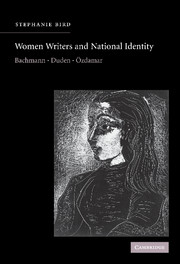Book contents
- Frontmatter
- Contents
- Acknowledgements
- Introduction
- PART I INGEBORG BACHMANN: THE TODESARTEN PROSE
- 1 Franza and the Righteous Servant
- 2 On sharks and shame
- 3 Malina: experience and feminism
- PART II ANNE DUDEN: THE SUFFERING BODY
- PART III EMINE ÖZDAMAR: PERFORMANCE AND METAPHOR
- Conclusion: das war es
- Notes
- Bibliography
- Index
3 - Malina: experience and feminism
Published online by Cambridge University Press: 22 September 2009
- Frontmatter
- Contents
- Acknowledgements
- Introduction
- PART I INGEBORG BACHMANN: THE TODESARTEN PROSE
- 1 Franza and the Righteous Servant
- 2 On sharks and shame
- 3 Malina: experience and feminism
- PART II ANNE DUDEN: THE SUFFERING BODY
- PART III EMINE ÖZDAMAR: PERFORMANCE AND METAPHOR
- Conclusion: das war es
- Notes
- Bibliography
- Index
Summary
The critical emphasis in the previous chapter on narrative technique is also central to my approach to Ingeborg Bachmann's novel Malina. It is a book which lends itself to interpretations which are based on the dichotomy of male and female. The text is itself structured around this opposition; the narrator is a woman, and the three chapters focus on her relationship to three male figures: her lover Ivan, the father and Malina, her companion and alter ego. The narrator expresses the suffering which these relationships cause her, finally describing her disappearance into a crack in the wall as ‘murder’, with Malina standing as the obvious perpetrator, but with Ivan and the father implicated as other men who have failed to understand her. Not surprisingly, Malina, written in 1967–70, has become one of the major works of the women's writing canon.
The confrontational structure of Malina has encouraged feminist criticism which emphasizes the oppression of the female narrator by the male figures. Her emotional stance, her difficulty in articulating her subjectivity and her debilitating relationships with the egoistic Ivan, her cruelly analytic alter ego Malina, and the sadistic father-figure are seen as testifying to the impossibility of the existence of ‘woman’ in patriarchy. As a writer, the narrator represents female creativity, which is threatened and finally eradicated by the three men.
- Type
- Chapter
- Information
- Women Writers and National IdentityBachmann, Duden, Özdamar, pp. 64 - 92Publisher: Cambridge University PressPrint publication year: 2003



